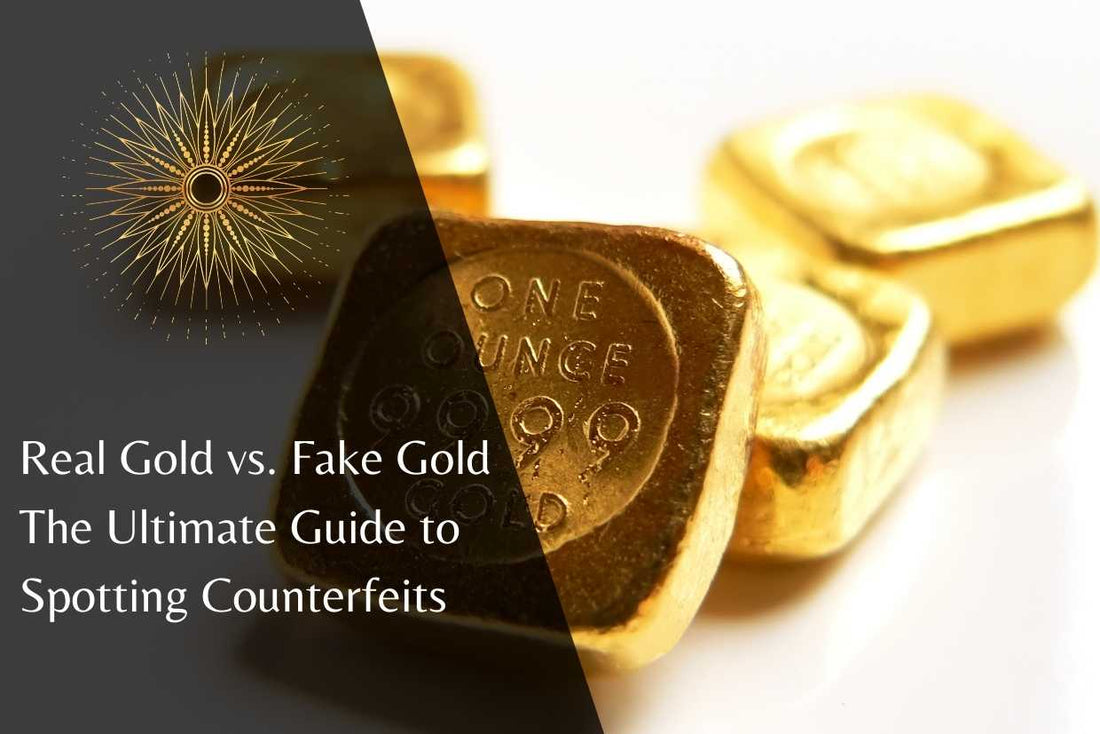
How to Identify Real Gold and Fake Gold Jewellery: A Comprehensive Guide
In the dazzling world of Jewellery, understanding the difference between real gold and fakes is crucial. With advancements in manufacturing technology, imitations can be deceptively similar to genuine pieces. Being aware of the key distinctions can prevent you from ending up with inferiorJewellery that lacks lasting beauty and might cause allergic reactions due to base metals. This guide equips you with the knowledge to confidently invest in authentic pieces that will bring you joy for years to come.
Welcome to Your Guide on How to Differentiate Real Gold from Fake Jewellery.

This comprehensive guide is designed to be informative and user-friendly, regardless of your experience with precious metals. Whether you're a seasoned buyer or a complete novice, you'll find valuable insights and practical advice to ensure you're handling genuine gold Jewellery. By understanding what to look for when purchasing Gold Jewellery, you can avoid falling victim to counterfeits.
1. Hallmark Examination: The Key to Authenticity.

Hallmark is official markings stamped on Jewellery to verify its purity. Understanding these hallmark is vital for discerning real gold from fakes. Look for the karat (kt) marking, which indicates the gold's purity. Common purity levels are 14kt, 18kt, 22kt, and 24kt, with higher karat numbers signifying a greater percentage of gold. For example, 18kt gold is composed of 75% gold and 25% alloy.
In addition to karat markings, you might also find a maker's mark that identifies the manufacturer and a country mark indicating the origin of the piece. These markings provide further assurance of the Jewellery's authenticity and provenance.
2. Visual Inspection Techniques: A Keen Eye for Quality.

Developing a keen eye is essential when differentiating real from fake gold Jewellery. Here's what to pay attention to:
- Color: Real gold has a warm, natural luster. It can come in various shades like yellow, rose, and white. Fakes often mimic these colors using brass or plating, but they may lack the subtle undertones and richness of genuine gold.
- Surface Finish and Texture: Counterfeit Jewellery might have imperfections like indentations or pitting on the surface. Authentic pieces, on the other hand, will have a smooth and polished finish. Uneven coloring and a low-quality polish are also signs of a fake.
- Signs of Wear: Look for signs of wear or chipping, which can indicate gold plating rather than solid gold. In plated Jewellery, wear is typically most evident on areas that frequently come into contact with skin or clothing.
By familiarizing yourself with these visual cues, you'll be better equipped to identify authentic pieces and avoid costly mistakes.
3. Weight and Density Test: Feeling the Difference.

Real gold is a dense metal, so genuine gold Jewellery will feel heavier than its size might suggest compared to a fake counterpart. At home, you can use a genuine coin or another item of known weight as a reference point to get a general sense of your jewelry's weight.
However, it's important to remember that this test isn't foolproof. Fakes can be crafted from lighter materials or made hollow to mimic the weight of real gold. Conversely, some counterfeiters might use denser metals to deceive buyers. It's best to use this test in conjunction with others for a more comprehensive evaluation.
4. The Magnet Test: A Simple Initial Check.

Here's a quick and easy way to get a preliminary indication of authenticity: the magnet test. Since gold is non-magnetic, if a strong magnet attracts your Jewellery, it's likely not real gold and contains other metals.
Important Note: This test has limitations. Some non-magnetic metals can be used to create convincing fakes, and some genuine Jewellery pieces might have magnetic clasps or components that could cause a false positive. Therefore, while the magnet test can be a helpful initial step, it shouldn't be the sole method of verification.
5. Consulting a Professional: The Definitive Answer.

For the most reliable assessment, especially for valuable pieces, it's highly recommended to consult a professional jeweler or gemologist. They have access to advanced testing equipment, like the X-ray fluorescence (XRF) analyzer, which can accurately determine the composition and purity of your Jewellery.
6. Reliable Jewelers and Professionals: Invest with Confidence.

Purchasing Jewellery from a reputable jeweler is crucial. Professional jewelers conduct thorough testing to determine the karat weight and authenticity of their pieces. By choosing a trustworthy jeweler, you can be confident that you're investing in genuine gold Jewellery that will retain its value and beauty for years to come.
FAQ.
Is there a magnet test for real gold?
Yes, the magnet test can be used as an initial check for authenticity. Real gold Jewellery is not magnetic. If a magnet attracts your Jewellery, it likely contains other metals. However, this test is not definitive since some non-magnetic metals can be used to create realistic fakes.
What is the difference between karat and gold-plated?
The karat (kt) refers to the purity of gold. Lower karat numbers indicate a higher mix of gold with other metals for increased durability. Gold-plated Jewellery has a thin layer of gold applied to a base metal, which is often less expensive. Gold-plated Jewellery can wear off over time, revealing the base metal underneath.
How can you clean real gold Jewellery?
You can safely clean your gold Jewellery using a solution of warm water and mild dish soap. Gently brush the Jewellery with a soft cloth. For stubborn dirt, use a soft toothbrush carefully and rinse it thoroughly with clean water to remove soap residue and dry it completely with a soft cloth.
Conclusion.
Distinguishing real gold from fakes is essential for anyone considering an investment in quality Jewellery. This guide equips you with the knowledge and tools to make informed decisions. Remember, consulting a reputable jeweler and verifying the authenticity of your purchases is crucial for ensuring you get what you pay for. By following these tips, you can confidently invest in beautiful and timeless pieces of genuine gold Jewellery.
